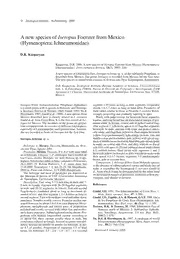
A new species of Iseropus Foerster from Mexico (Hymenoptera: Ichneumonidae) PDF
Preview A new species of Iseropus Foerster from Mexico (Hymenoptera: Ichneumonidae)
© Zoological Institute, St.Petersburg, 2006 A new species of Iseropus Foerster from Mexico (Hymenoptera: Ichneumonidae) D.R. Kasparyan Kasparyan, D.R. 2006. A new species of Iseropus Foerster from Mexico (Hymenoptera: Ichneumonidae). Zoosystematica Rossica, 14(2), 2005: 210. A new species of ichneumon-flies, Iseropus hylesiae sp. n. of the subfamily Pimplinae, is described from Mexico. The genus Iseropus is recorded from Mexico for the first time. The new species is reared from cocoons of Hylesia iola Dyar (Lepidoptera, Saturniidae). D.R. Kasparyan, Zoological Institute, Russian Academy of Sciences, Universitetskaya nab. 1, St.Petersburg 199034, Russia & División de Postgrado e Investigación, UAM Agronomía y Ciencias, Universidad Autónoma de Tamaulipas, Cd.Victoria, Tam. 87149, Mexico. Iseropus Först. (Ichneumonidae: Pimplinae: Ephialtini) segment 1.85 times as long as fifth segment). Ovipositor is a small genus with 8 species in Holarctic and Neotrop- sheath 1.6-1.7 times as long as hind tibia. Parameres of ic Regions (Townes & Townes, 1960; Gauld, 1991; Yu & male rather similar to those in Nearctic I. coelebs Walsh: Horstmann, 1997; Gauld et al., 1998). A new species from strongly projecting and gradually tapering to apex. Mexico described here is closely related to I. serranoi Black, with palpi (except for brownish basal segment), Gauld et al. from Costa Rica. It is the first record of Ise- tegulae, and long broad line on dorsolateral margin of pro- ropus for Mexico. The members of the genus are gregar- notum white. In female, ventral side of pedicel and of flag- ious ectoparasitoids in cocoons of different Lepidoptera, ellar segment 1 yellowish; apical 8-10 flagellar segments especially of Lasiocampidae and Lymantriidae. Saturnii- brownish. In male, antenna with scape and pedicel anteri- dae are recorded as hosts of Iseropus for the first time. orly white, and flagellum yellowish. Pterostigma brownish yellow. Legs predominantly light orange (in male, fore and Iseropus hylesiae sp. n. middle coxae and trochanters pale yellow) with apical seg- ment of middle tarsus brownish; hind tibia pale rufous (paler in male) on ventral side (0.4), and dirty whitish on dorsal Holotype: F, Mexico, Tlaxcala, Huamantla, ex: Hyle- side (0.6) with apex (0.25) and subbasal dorsal mark (about sia iola Dyar, Agosto 2001. 0.1) reddish brown. Hind tarsus with segments 1 and 2 Paratypes. Mexico: Tlaxcala, 9 F, 8 M with same label brownish yellow (in female) or dirty whitish (in male) with as in holotype; Chiapas: 1 M, municipio San Cristobal de their apical 0.3-0.7 brown; segments 3-5 predominantly Las Casas, reserve Huitepec, ex: nido Hylesia sp. (Lepi- brown, pale at extreme base. doptera, Saturniidae) sobre Arbutus xalapensis (Ericaceae), Comparison. I. hylesiae differs from Holarctic species 26.I.2005 (Y. Balam Ballote); 7 F, same data, but in the absence of submetapleural carina and black face of 17.II.2005; Tamaulipas: 1 F, km 22-25, NE Miquihuana, male; it resembles the Neotropical I. serranoi Gauld et 2800 m, Pinus con Arbutus, 12.V.2000 (Kasparyan). al., from which it may be distinguished by the white band The holotype and most of paratypes are deposited at on dorsolateral margin of pronotum, brownish yellow pte- the Museum of Insects of UAT (Universidad Autónoma rostigma, and shorter ovipositor. de Tamaulipas, Cd.Victoria, Mexico). Description. Fore wing 5-7.5 mm long in male and 7- 9 mm, in female. Antenna with 26-29 flagellar segments References in male and 29-31 segments, in female; first and second flagellomeres combined about as long as maximum di- Gauld, I.D. 1991. The Ichneumonidae of Costa Rica, 1. ameter of eye, and first segment 1.5-1.6 times as long as Mem. Amer. entomol. Inst., 47: 1-589. second segment. Face with medium-sized and rather dense Gauld, I.D., Ugalde, J.A. & Hanson, G.Y.P. 1998. Guía punctures. Temples weakly convex. Posterior ocellus sep- de los Pimplinae de Costa Rica (Hymenoptera: Ich- arated from eye by about 0.8-0.9 its own diameter. Meso- neumonidae). Rev. Biol. trop., 46 (Sup. 1): 1-189. pleurum, metapleurum and lateral parts of propodeum Townes, H.K. & Townes, M. 1960. Ichneumon-flies of polished and evenly covered with rather fine and moder- America north of Mexico: 2. Subfamilies Ephialti- ately dense punctures. Submetapleural carina absent. Pro- nae, Xoridinae, Acaenitinae. US nat. Mus. Bull., podeum with median longitudinal carinae extending to 216(2):1-676. its apical 0.6; these carinae usually sharp in male, but Yu, D.S. & Horstmann, K. 1997. A catalogue of world sometimes reduced in female. Second recurrent vein def- Ichneumonidae (Hymenoptera). Mem. Amer. etomol. initely beyond the middle of areolet (in holotype, at dis- Inst., 58(2): 764-1558. tal 0.7 of areolet). Proportion of segments 1-5 of hind tarsus (in holotype) 5.3 : 2.6 : 1.6 : 0.7 : 1.4 (second Received 4 January 2006
